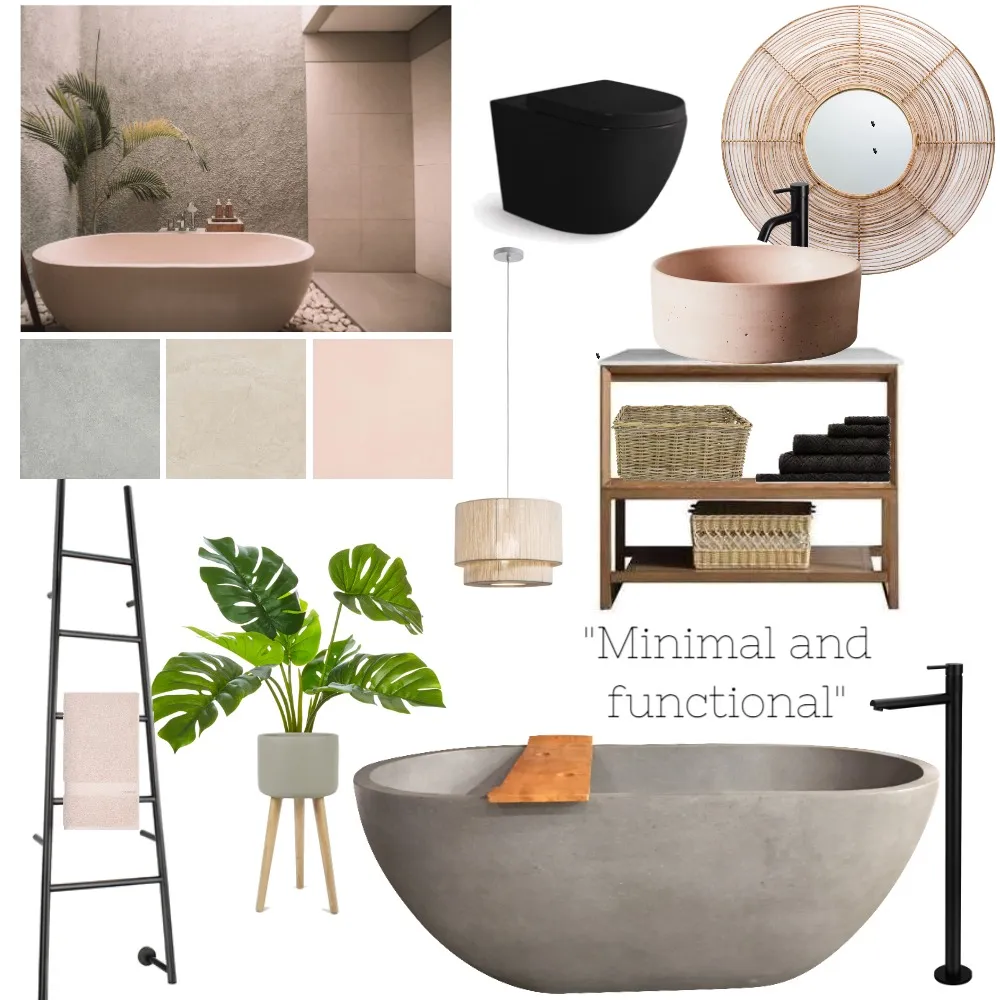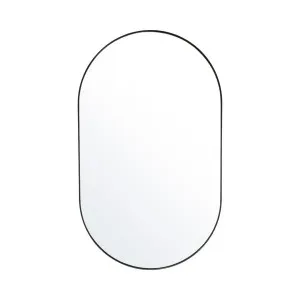Ideas
12 Japandi Bathroom Ideas
Japandi combines the beauty and elegance of Japanese design with the functionality of Scandinavian design. It is envisioned to be minimal, calm, and organised. All clutter is put away or removed, and each item in the room is thoughtfully placed to add functionality and minimise distractions.
Japandi's aim in the bathroom is to create a tranquil, calming environment. Every element in the room should bring a sense of cosiness, and comfort, and be placed with purpose. We've put together a list of some of the top 12 ideas to help you get started designing your own Japandi bathroom.
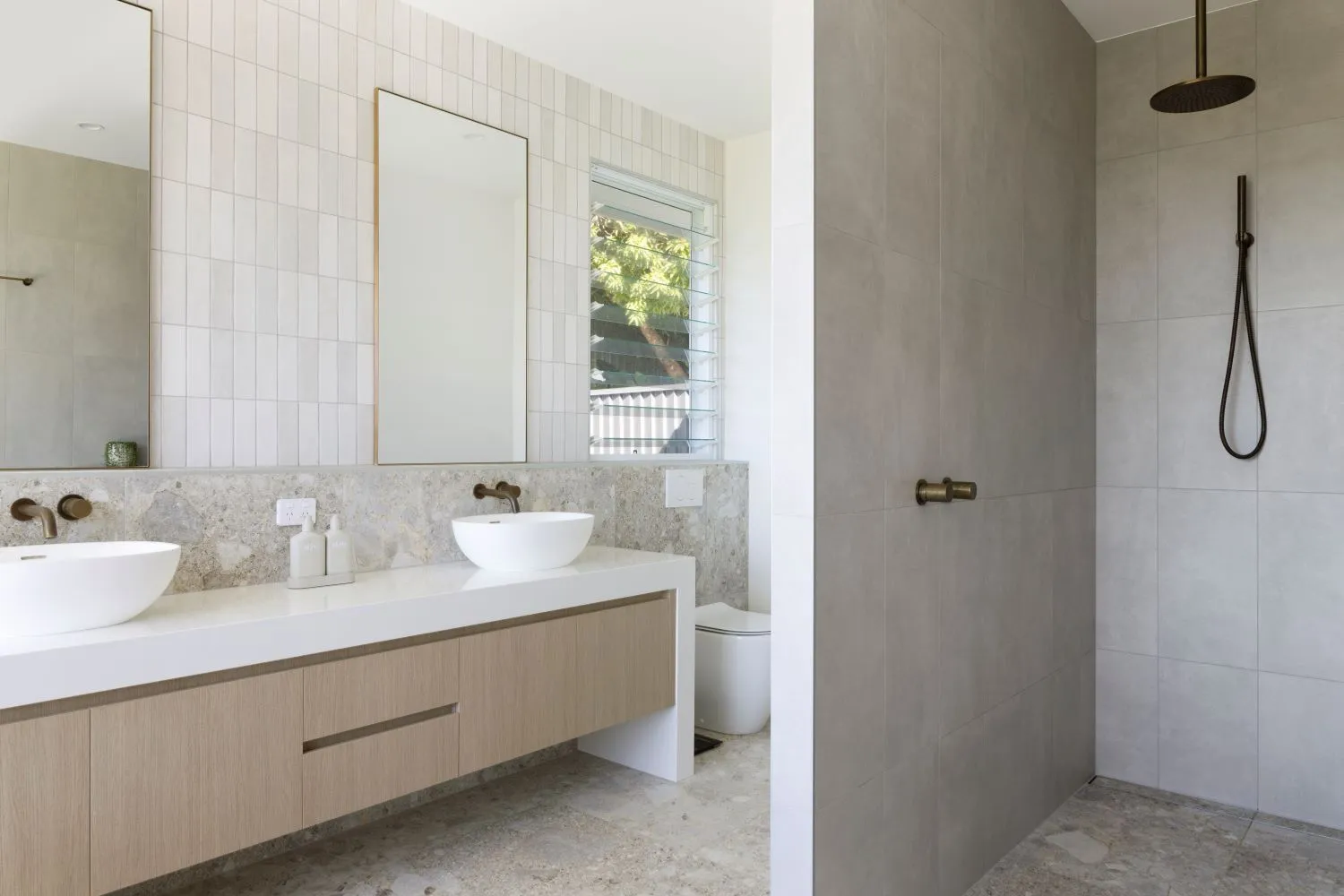 Image Credit: @mulberry_manor | Villa Styling
Image Credit: @mulberry_manor | Villa Styling
1. Choose Muted Shades for the Wall
The classic Japandi colours are perfect for creating a soothing atmosphere in your bathroom. Earthy hues and neutral shades are comforting and don’t overwhelm the room. Opt for muted shades of white, grey, beige, or even soft blue or green for your bathroom walls. These colours are easy on the eyes and provide a relaxing backdrop to the space.
Keep to similar tones to those you would use for tiles and flooring to create a cohesive Japandi theme. Combine beiges or pastels with rich brown wood for a reference to traditional Japanese design. This helps your walls feel brighter while remaining cohesive.
To add some depth to the room, consider layering shades. This gives contrast, texture, and depth to your Japandi space.
Explore our bathroom product library with incredible Japandi style products and more.
 Image Credit: @orton.haus
Image Credit: @orton.haus
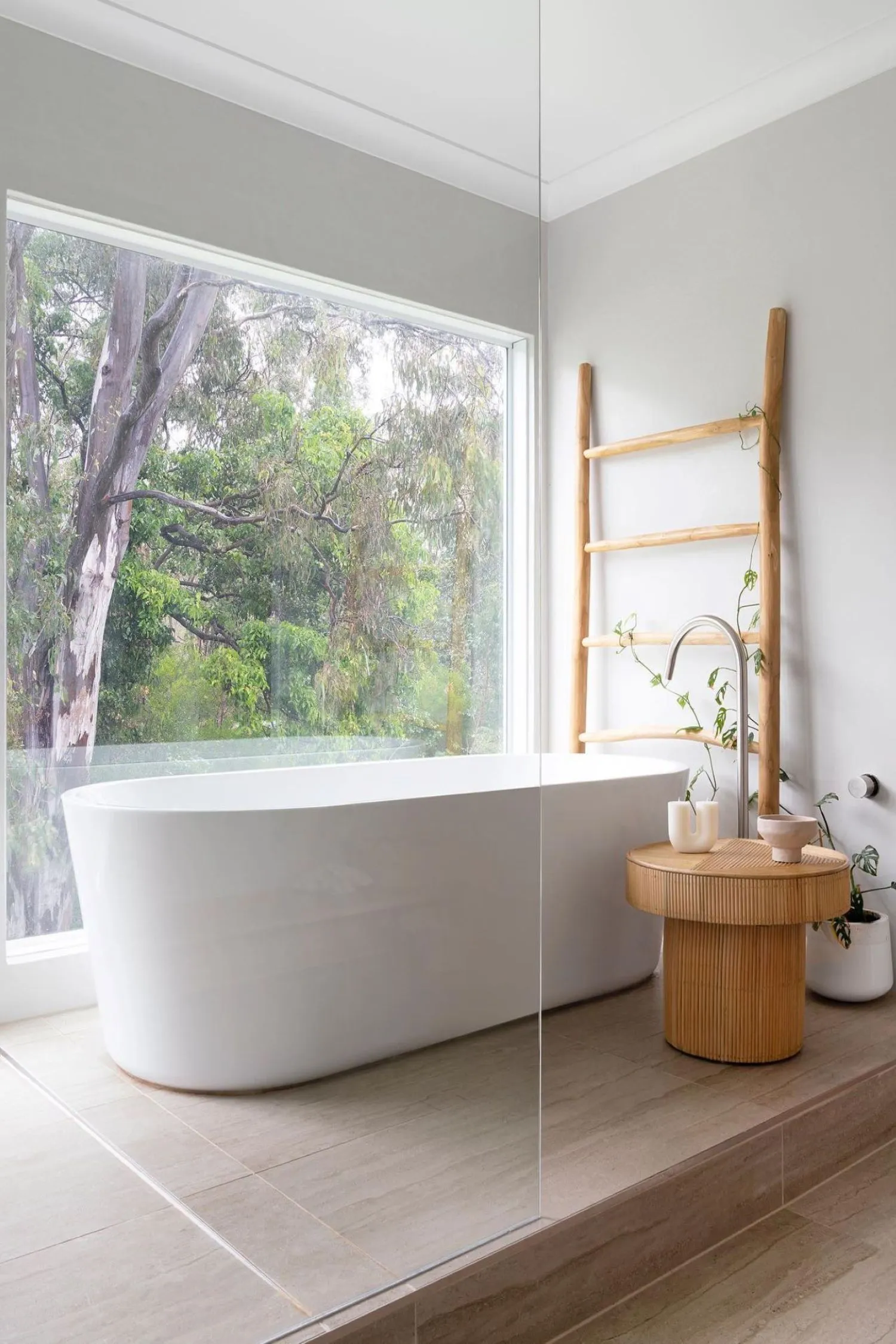 Image Credit: Villa Styling
Image Credit: Villa Styling
2. Bring in Some Warmth with Textiles
One of the most effective ways to bring warmth and texture to your Japandi bathroom is through soft and cosy textiles. Fortunately, in a bathroom this can be easily done with items such as linen towels, rugs, or deep pile bathmats. You can also add a wooden bench to bring in a touch of nature or play with shapes through an organic-shaped mirror.
Choose natural materials like cotton, linen, or bamboo, in earthy tones, and keep the patterns simple and understated. Feel free to choose the fluffiest and softest towels for your comfort. When it comes to your bathmat you can either go for a wooden option to add more natural accessories or choose one that is tufted with cotton.
3. Make your Bath the Focal Point
In a Japandi bathroom, the bath is the centrepiece of the room. Bathing is deeply embedded in Japanese culture, dating back to the 6th century. It was a place to cleanse your body and spirit to improve your health.
Consider investing in a deep soaking tub maximise your relaxation when bathing. Place it in a central position, freestanding or against the wall. It should be the first thing people see when they enter the room. Surround it with natural materials and subdued lighting for an even more peaceful ambience. We love the Fienza Bahama Matte White Freestanding bath from The Blue Space.

4. Keep things Minimal and Sleek
In Japandi design, less is more. Your Japandi bathroom is a place for tranquillity and calm. To achieve that spa-like feel, remove unnecessary handles or bulky fixtures. Instead, opt for sleeker options with smooth lines. Try a wall-mounted toilet and simple shaped sinks to reduce any unnecessary clutter.
Keep your bathroom accessories and decor to a minimum. Too many items in your bathroom can start to make it feel cluttered and chaotic. Keep lotions and other items hidden in sleek minimalist cabinets.
5. Japandi Focuses on Functionality First
The Japandi philosophy is all about function and purpose. Each item needs to have a purpose in the room. When you are trying to develop a minimal, clutter-free style this functionality becomes incredibly important.
Clever storage is going to be your best friend here. All bottles, jars, and tubes should be stored behind a closed door. Try smart storage solutions (this is where Scandinavian design comes in) to keep your bathroom essentials organized. Closets under the sink, or on their own are great. However, take it a step further by making it the same colour as your wall so it can blend in. Another alternative is a mirror with a cupboard behind it.
If it looks great and is functional then you have hit the Japandi jackpot.
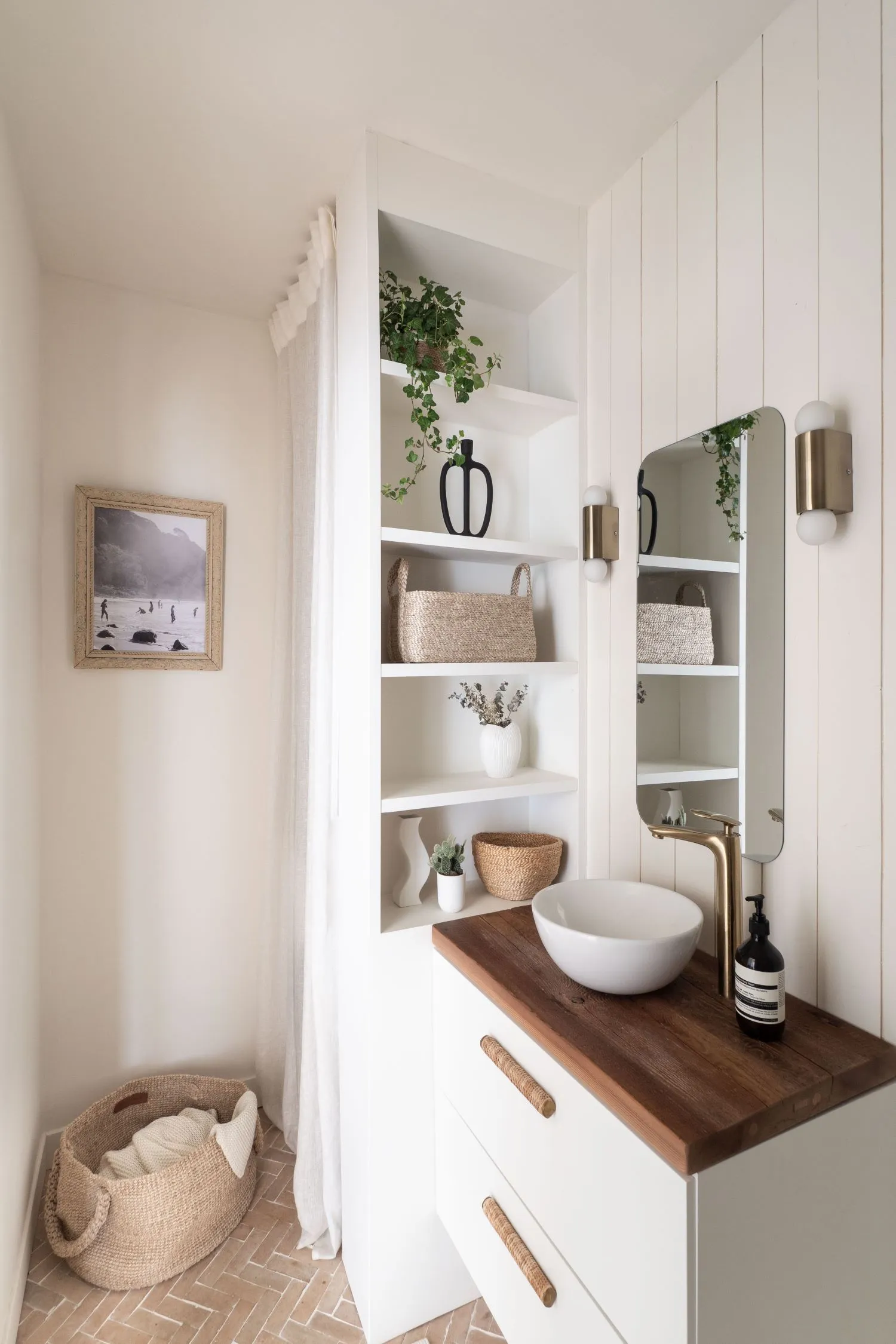 Image Credit: @amastudiointeriors
Image Credit: @amastudiointeriors
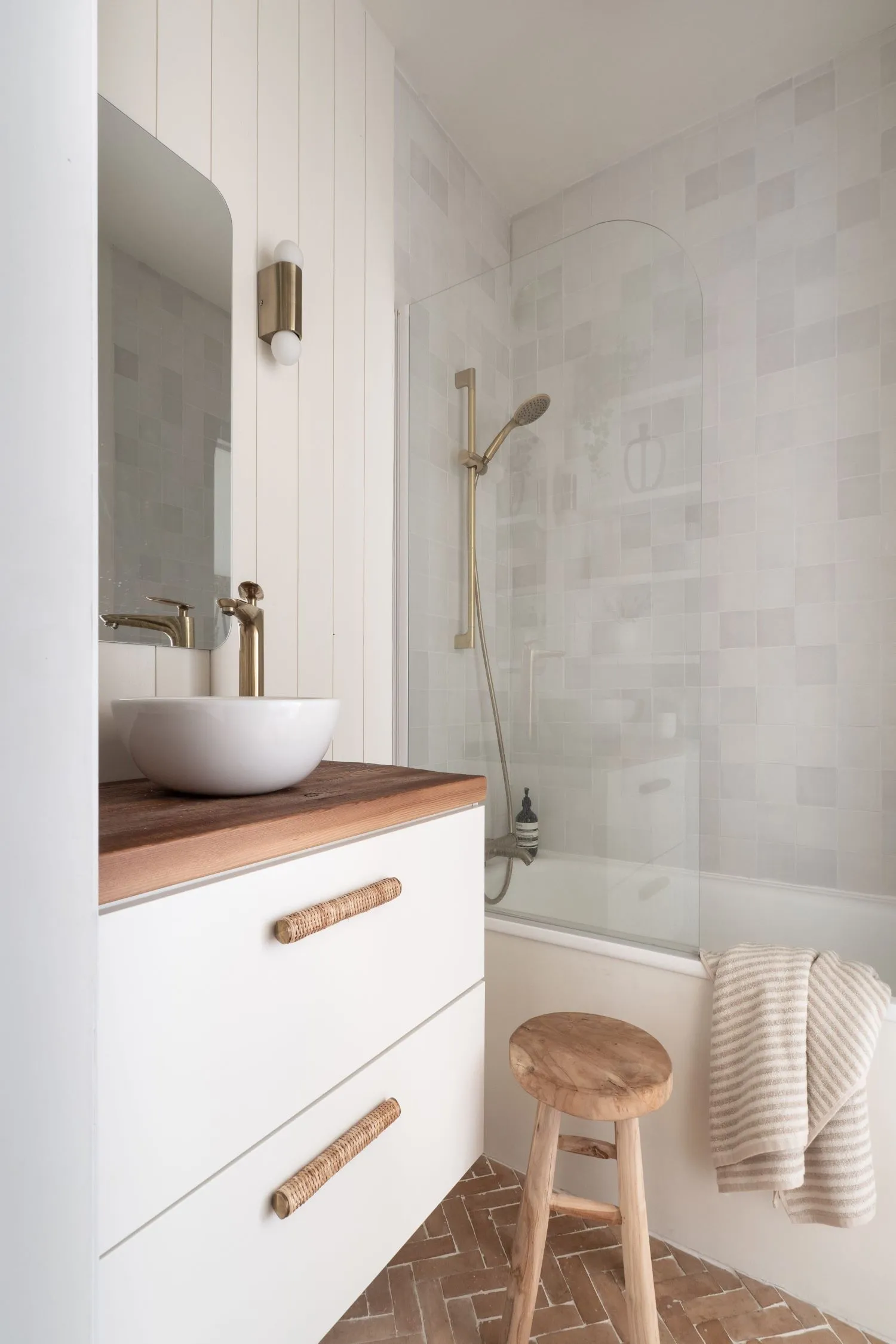 Image Credit: @amastudiointeriors
Image Credit: @amastudiointeriors
6. Play Around with Textures to Create Interest
While Japandi design is all about simplicity, it doesn't have to be boring. Add interest to your bathroom by layering different textures. Tiles are an easy place to inject different textures. Look for designs that are elegant and simple, such as smooth tiles with an architectural edge. By having a gentle colour shift between tiles, you have a sense of movement and texture that is soothing and pleasing to the eye.
Alternatively, play around with wood. Bringing nature inside through items like a rough-hewn wooden stool, or a woven storage basket adds a sense of calm and interest. Natural materials bring alternating textures and patterns that are subtle but interesting.
7. Bring in a Calming Vibe Through Low Level Lights
Lighting is the key to creating a tranquil bathroom. Your Japandi bathroom is designed to be a calming and relaxing sanctuary, so your lighting needs to match. Use soft, ambient lighting to create a relaxing atmosphere, such as wall sconces or pendant lights. Consider using dimmer switches for added control over lighting levels.
Experiment further with your lighting by adding unusual glass coverings or lampshades to change the texture of your lighting. Incorporating natural materials like wicker, or using organic shapes is very Japandi.
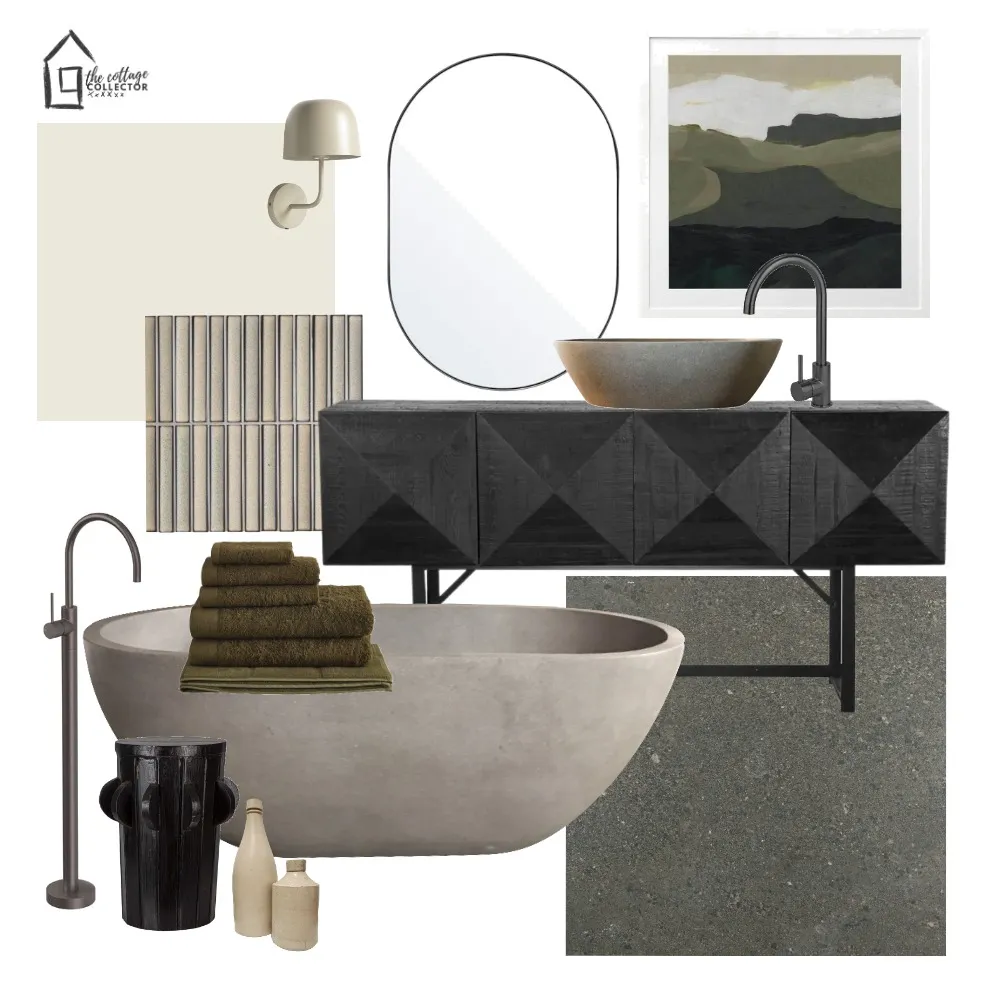 Mood board credit by The Cottage Collector, on Style Sourcebook, view mood board here.
Mood board credit by The Cottage Collector, on Style Sourcebook, view mood board here.
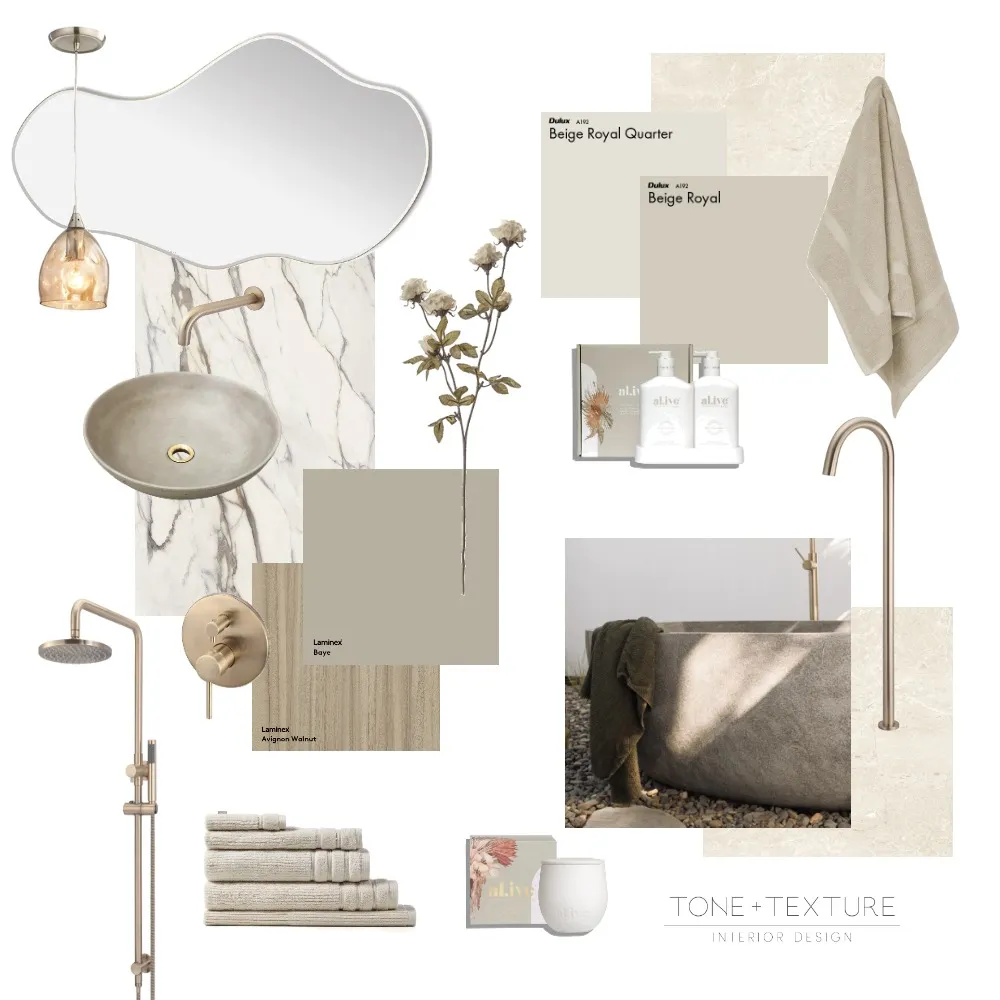 Mood board credit by Tone & Texture Interior Design, on Style Sourcebook, view mood board here.
Mood board credit by Tone & Texture Interior Design, on Style Sourcebook, view mood board here.
8. Use Plants as Accessories
Add a touch of nature to your Japandi bathroom through indoor plants. Nature is at the core of Japandi design due to its simplicity and calming properties. Adding a touch of green to your bathroom not only creates some brilliant contrast to the neutral shades but brings a sense of Zen into the room.
Plants and natural materials are the way to bring accent colours into a Japandi room. But don’t fret if you don’t have a green thumb, there are a lot of low-maintenance plants to choose from. Try plants such as succulents, ferns, or snake plants, and display them in simple, minimalist planters.
9. Take Advantage of Black Accents
Incorporating black accents into your Japandi bathroom can create a striking contrast against the muted colour palette. Matte black accents are very Japanese and provide balance to the muted colours throughout the room. Consider adding black hardware, such as faucets or showerheads, or a black-framed mirror to add depth and interest to the space. Dark textiles like bathmats and towels also help to create a calming atmosphere. We love this oval mirror from Granite Lane.
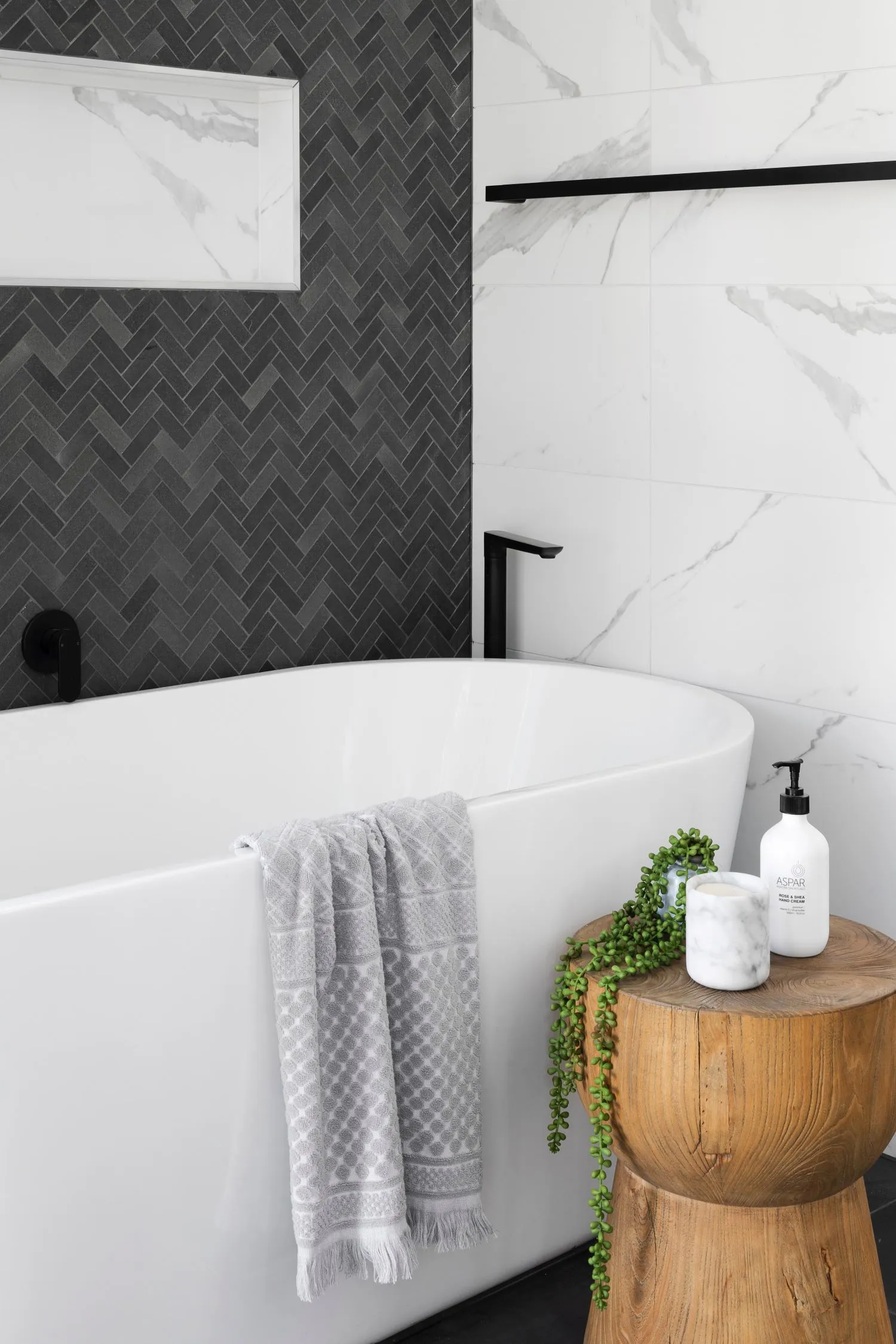

10. Utilise Natural Materials
Japandi design places a strong emphasis on natural materials, such as wood and stone, and there is no better place to use these materials than flooring. Japandi rooms love wooden flooring. When it comes to the bathroom, the most effective way to achieve this effect is through vinyl flooring. Vinyl boasts water and slip-resistant properties while remaining affordable and easy to maintain. It can also look amazing!
If you do want to stick with real wood, be careful. Ensure that you choose a wood that can withstand the levels of humidity and moisture bathrooms experience. Softwoods are not the right choice here. It will also require more maintenance as you need to regularly reseal the wood to ensure no moisture gets in.
11. Keep Sustainability on Your Mind
Sustainability is an influential element of Japandi design. Japandi is all about quality pieces with timeless designs that you can keep for a long time. These pieces are made from sustainable or renewable resources like bamboo or other ethically sourced woods. Other sustainable materials like copper or natural stone are perfect additions too.
Consider reducing waste and water consumption through your fixtures. Water-saving shower heads and taps can give the feeling of high pressure while using very little water. Other additions like bidets (which are very Japanese) help reduce waste and clutter.
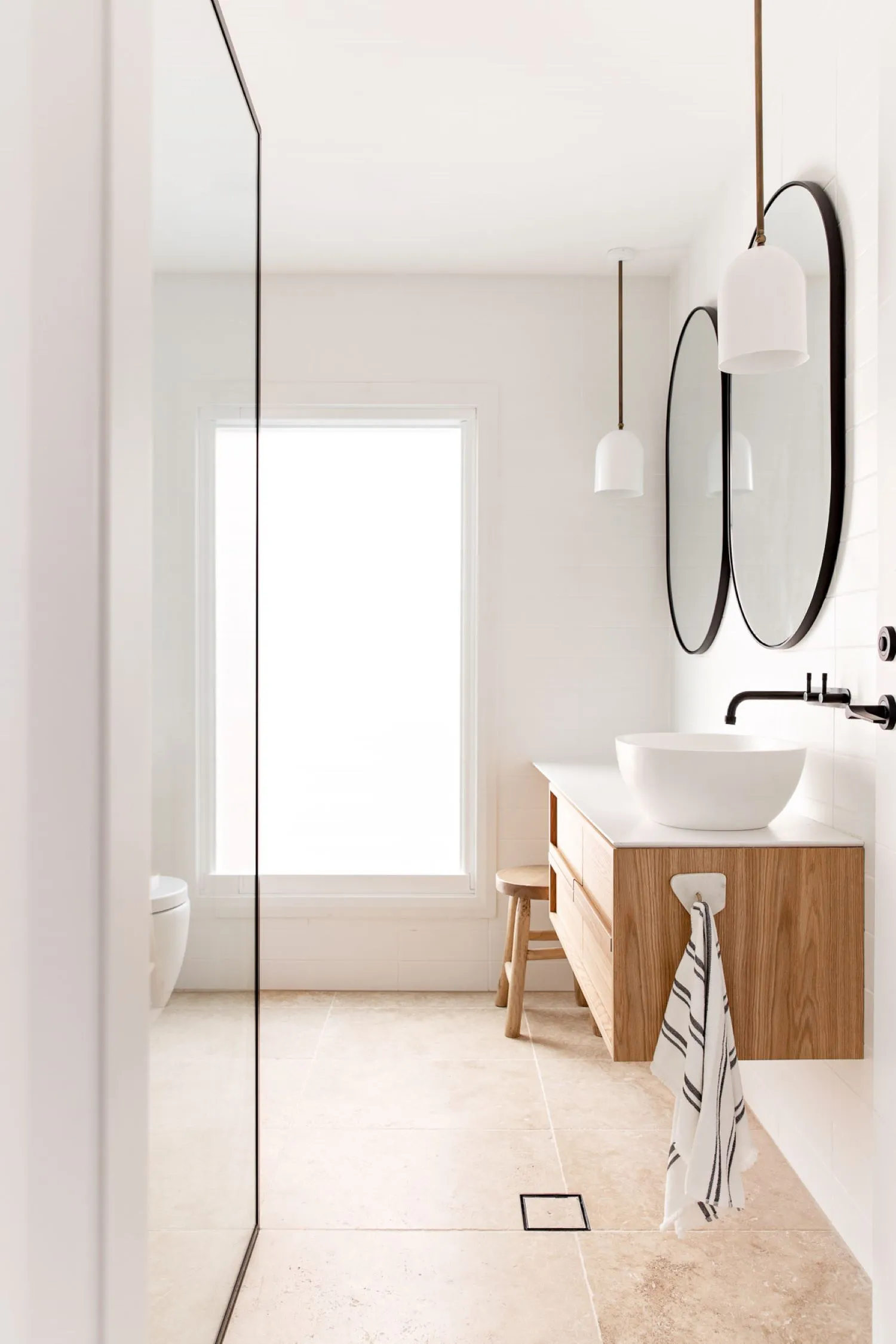 Image Credit: @theshoreatgerringong | Nat Spada
Image Credit: @theshoreatgerringong | Nat Spada
 Image Credit: @jessi.eve | Villa Styling
Image Credit: @jessi.eve | Villa Styling
12. If You Love Dark Dolours, You Can Still Try Japandi Style
For those who love dark colour palettes, but also love the concepts and ideas behind Japandi, do not worry, you can also create a gorgeous dark Japandi bathroom. The key elements of Japandi still remain the same in a dark room. Simplicity, comfort, tranquillity, and the use of natural materials.
Use darker shades of grey, navy, or black. Keep the lines simple and the decor to a minimum to create a cohesive and calming space. Ensure the lighting remains deep and moody, to create a sense of dark tranquillity.
Feeling inspired? Design your dream Japandi bathroom with our mood board tool.
Frequently Asked Questions:
What is a Japandi Bathroom?
A Japandi bathroom is a space that blends elements of Japanese and Scandinavian (often referred to as Scandi) design styles. This fusion creates a bathroom that is both minimalistic and warm, emphasising clean lines, natural materials, and a serene, clutter-free environment. The Japanese influence brings in aspects of Zen philosophy, focusing on tranquillity and simplicity, while the Scandinavian touch adds functionality and comfort with a muted, neutral colour palette.
What is the Difference between Wabi-Sabi and Japandi?
While both wabi-sabi and Japandi share a love for simplicity and natural materials, they have distinct philosophies and aesthetics:
Wabi-Sabi: This is a traditional Japanese aesthetic that finds beauty in imperfection and transience. It embraces the flawed or the incomplete, appreciating the marks of wear and time. Wabi-sabi is more about embracing the natural state of things and less about a specific design style.
Japandi: Japandi, on the other hand, is a hybrid design style that combines the modern, clean lines of Scandinavian design with the elegance and simplicity of Japanese aesthetics. It’s more structured than wabi-sabi and focuses on blending two distinct design traditions into a cohesive whole.
What are the Rules of Japandi Style?
Minimalism: Japandi style is grounded in a less-is-more approach. It advocates for simplicity and the elimination of unnecessary elements.
Natural Materials: Materials such as wood, bamboo, stone, and textiles like cotton and wool are predominant, reflecting a connection to nature.
Neutral Colours: The colour scheme in Japandi design is typically understated, featuring earthy and neutral tones.
Functionality: Every item in a Japandi-style room should have a purpose. This stems from the Scandinavian influence, which prioritises functionality.
Craftsmanship: There's a strong emphasis on high-quality, handcrafted items, which mirrors the Japanese appreciation for artisanal skills.
Mix of Old and New: Japandi style often combines modern pieces with traditional elements, creating a balance between old and new.

